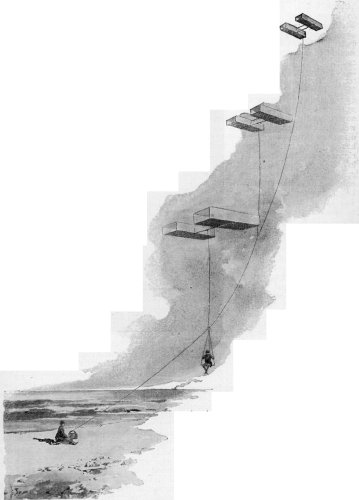
On the long peninsula that separates New York Bay from Newark Bay, there is, among other things, a red house by an open field, in which lives the king of kite-flyers. Every one in Bayonne, the town which covers this peninsula, knows the red house by the open field; for scarcely a day passes, winter or summer, that kites are not seen sailing above this spot—sometimes a solitary "hurricane flyer," when the wind is sweeping in strong from the ocean; sometimes a tandem string of seven or eight six-footers, each one fastened to the main line by its separate cord. And wonderful are the feats in kite-illumination accomplished by Mr. Eddy (the king aforesaid) on holiday nights, especially on the Fourth of July, when he keeps the sky ablaze with gracefully waving meteors, to the profound awe or admiration of his fellow-townsmen.
If you enter the red house and show a proper interest in the subject, Mr. Eddy will take you up to his kite-room, where skyflyers of all sorts, sizes, and materials range the walls—from the tiniest, made of tissue paper, to nine-footers, with lath frames and oil-cloth coverings. Hanging from the ceiling is one of the queer Hargrave kites, which looks like a double box, and seems as little likely to fly as a full-legged dining-table; yet fly it will, and beautifully too, though by a principle of aŽroplanes only recently understood.
Then Mr. Eddy will show you the room where, with the help of his deft-fingered wife, also a kite enthusiast, he spends many hours developing and mounting photographs taken from high altitudes, with a camera especially constructed to be swung and operated from the kite cord.
Until one talks with a man like Mr. Eddy—though, indeed, there is no one just like him—one does not realize what a large and important subject this of scientific kite-flying is. Many men of distinction have devoted years of their best energies to experiments with kites. Mr. Eddy himself is a scientist first, last, and always; for the sake of a new observation he will send up a tandem of kites when the thermometer is below zero, or stand half a night at his reeling apparatus, getting records of the thermograph.
Perhaps I shall do best to begin by giving some useful information to those who may contemplate constructing a modern scientific kite. The first thing that should be done by such a person, be he boy or man, is to rid his mind of all his preconceived [pg 380]notions about kites, for it is almost certain that they are incorrect. To begin with, the scientific kite has no tail. A few years ago people would have laughed at any one who attempted to send up a kite without a tail. But the question is now no longer even open with the scientific kite-flyers, who not only send up tailless kites with the greatest ease, but do so under conditions which, to kites with tails, would be impossible: for instance, in dead calms and in driving hurricanes. The tailless kite, sent from the hands of a master, will fly in all winds.
It is true that kites with tails have given good results in experimental work; but the tails are annoying and an unnecessary weight, and may better be dispensed with. Every boy has had the vexatious experience of sending up a kite in a light breeze with a tail made light in proportion, only to find that, on reaching stronger air currents above, the kite has begun to dive and grow unmanageable. Then, when he has taken the kite down and added a heavier tail, he has found the breeze at the ground insufficient to lift the extra load; and so, between two difficulties, has had to give up his sport in disgust. This is the one serious defect of kites with tails, that they cannot adapt themselves to wind currents of varying intensities; whereas the tailless kites do so without difficulty. And in tandem flying, which is the backbone of the modern system, the weight of a half dozen or more heavy tails would be a serious impediment, to say nothing of the perpetual danger of the different tails getting entangled in the lines.
It is important, then, to know how to make a scientific tailless kite, such as is used by the experts at the Smithsonian Institution, or at the Blue Hills Conservatory near Boston, for it must not be supposed that kite-flying is merely an idle pastime; it is a pleasure doubtless for boys, but it is also a field of serious experiment and observation for men. The information I here present, including practical directions as well as interesting theories, was obtained from Mr. Eddy himself, and may be regarded as strictly accurate.
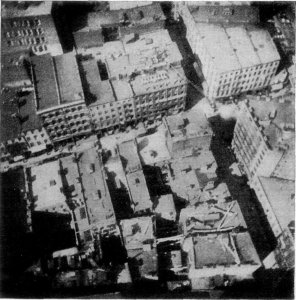
This view, from a photograph taken from a kite by Mr. W.A. Eddy, New York City at the crossing of Frankfort and William Streets.
It is much better for amateurs to begin with a kite designed to fly in strong winds, as it is a long and delicate task to learn to manage the variety with extra wide cross-stick meant for ascension in calms. The two sticks which form the skeleton should be of equal lengths, say six feet; and should cross each other at right angles at a point on the upright stick eighteen per cent. of its length below the top. This point of crossing is of great importance, and was only located by Mr. Eddy after months of wearisome experiment. He was misled in his earlier efforts at tailless kite-making by the example of the Malay kiter-flyers, who are reputed to be the most skilful in the world, and who cross the sticks much nearer the middle of the upright one. In a six-foot kite the two sticks, equal in length, should cross at about thirteen inches from the top of the upright stick; and the same proportion should be observed for kites of other dimensions. At the point of crossing, [pg 381]the sticks should be slightly notched, and strongly bound together with twine tied in flat knots. Driving a nail or screw through the sticks, to bind them, weakens the frame at the point of greatest strain.
As material for the sticks Mr. Eddy has found clear spruce better than any other wood. Bamboo is bad, because it bends unevenly at the joints. White pine is not tough enough, and cypress is both too brittle and too flexible. The hard woods, like ash, hickory, and oak, are too heavy; in scientific kite-flying, even so small a weight as a quarter of an ounce may make all the difference between failure and success. All winds are broken by frequent brief intervals of calm, and a kite must rely on its lightness to outride these. Whoever contemplates going seriously into kite-flying will do well to provide himself with a store of suitable sticks by purchasing a straight-grained, well-planed spruce plank, free from knots, and having it sawed on a circular saw into sticks five-sixteenths and seven-sixteenths inches in thickness, to be cut later into such lengths as he may choose.
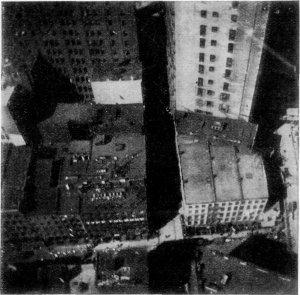
From a photograph taken from a kite by Mr. W.A. Eddy. This view also is of New York City about the crossing of Frankfort and William Streets. The high wall on the right of Frankfort Street is the back of the "World" building; the high wall on the left is the back of the "Tribune" building.
The two sticks (there are never more than two) having been fastened firmly together, the cross-stick must be sprung backward; so that, when finished, the kite will present a convex or bulging surface to the wind. It might be imagined that a concave surface to the wind would be better; and indeed this has been tried. But it has invariably proved that with a concave surface the kite receives too much of the breeze and becomes quite uncontrollable. The amount of spring that must be given the cross-piece is in proportion to its length, Mr. Eddy's rule being to spring the cross-stick, by means of a cord joining the two ends like a bow, until the perpendicular between the point of juncture of the two sticks and the centre of the cord is equal to one-tenth of the length of the cross-stick, or a little more than one-tenth, if the kite is to be flown in very high winds.
It is of the first importance to keep the two halves of the kite on the right and the left of the upright stick perfectly symmetrical. And this is by no means an easy matter. It often happens in bending the cross-stick that, owing to differences in the fibre and elasticity of the wood, one side bends more than the other, with the result that the two halves present different curves and consequently unequal wind areas. To offset this difficulty, and also to strengthen the skeleton, Mr. Eddy's practice is to add a bracing piece at the back of the cross-stick—a piece about one-fourth of the length of the cross-stick itself, and of the same width and thickness. If the two halves of the kite are already quite symmetrical, he places this bracing stick with its centre directly even with the point of juncture of the two large sticks, its two ends being fastened with twine to the cross-stick, about nine inches on either side of the crossing-point. But if one half of the cross-stick shows a greater bend than the other, he places the longer arm of the bracing piece toward the side that bends the most, thus presenting a greater leverage against the wind on that side than on the other, and so equalizing things.
With the two sticks and the brace all [pg 382]thus properly in place, a supporting frame for the paper or cloth is formed by running, not cord, but fine picture wire, over the tips of the sticks, notched to hold it in place, in the ordinary way. Then, with a thin, clear paste made of starch, the paper may be laid on, care being taken to paste the edges so as to leave a certain amount of slack or looseness in the part of the kite below the cross-stick, so that each of the lower faces will present concave wind surfaces. To preserve the required equilibrium, it is important that the amount of looseness in the paper be equal on the two sides; and in order to keep it so, it is necessary to measure exactly the amount allowed.

Front view, showing how the line is attached.
A storm-flyer.—The diamond-shaped figure in the centre is an opening made to lessen the wind pressure.
Those who wish to make many kites will do well to buy thin manilla paper, as wide as possible, having the dealer roll off for them seven hundred or eight hundred feet, say a yard in width, which will insure a cheap as well as an abundant supply. For strong winds and large kites it is best to use cloth as the covering. It should be sewed to the frame, and, if carefully put on, will do service for years. Silk, of course, is the ideal material; but its costliness puts it beyond ordinary means, and common silesia, such as is used in dress linings, is almost as good. Whatever the material, the kite should be fortified at the corners by pasting or sewing on quadrants of paper or cloth, so as to give double thickness at the points most liable to injury. A finished six-footer should not weigh over twenty ounces, if covered with paper; or twenty-five ounces, if covered with cloth. Mr. Eddy has made a six-footer for calm flying as light as eight ounces.
There is only one way to learn the practical art of kite-flying, and that is to begin and do the thing yourself—with many mishaps and disappointments at the outset. One of Mr. Eddy's practices when sending kites up in very light winds or in an apparent calm, is to reel out two hundred yards or so of cord in a convenient open space, leaving kite and cord on the ground until ready to start. Then, by taking the cord at the extreme distance from the kite, and beginning to run with it, he gets it quickly into the upper air currents, which are always stirring more than those at the surface. It is sometimes necessary to run for a considerable distance before the kite reaches a sustaining current; but a real kite enthusiast will not mind taking trouble; indeed he had better abandon the whole business if he does. It is worth noting that even in a dead calm a kite may be kept up indefinitely as long as the flyer is willing to run with the cord at the rate of about five miles an hour.
In flying kites tandem there is always to be guarded against the danger of a breaking of the cord. Few people realize how hard a pull is exerted by a series of kites well up in the air. A strain of twenty-five or thirty pounds on the cord is not uncommon; and not only the strength of the cord, but the way of attaching it, is of great importance. There should be two strings (never more), fastened to the upright [pg 383]stick at its lower end and at the point of crossing, the upper length being about one-third of the lower one, and the two being adjusted so that, when taut, the kite takes an angle of about twenty degrees with the ground—which means that the kite goes up almost straight overhead, the string making an angle of about seventy degrees with the ground.

It was by kites of this variety, flown in tandem, that the inventor, Hargrave, was lifted sixteen feet from the ground on November 12, 1894.
In sending up a series of kites to fly tandem, it is best to head the line with a small kite, three or, four feet in diameter, and gradually increase the size until a diameter of six feet is reached for the one sent last. This arrangement makes it possible to hold the upper kites by lighter cord, the heavier kites being reserved for the half of the line nearest to the ground; and thus there is a material lessening of the load to be borne. The first kite should be well up, say five hundred feet, before the second is attached to the line. But after that they maybe sent at closer intervals, sometimes with only a few hundred feet between them—say two hundred feet in light winds, and five hundred feet in heavy winds. Each kite in a tandem should have a length of at least one hundred feet of cord from the main line, and great care should be exercised in knotting fast the individual lines.
The best way of starting a second kite, after the first is well up, is to pay out about a hundred feet of cord for the tandem line, attaching one end of this to the main cord and the other to the second kite, which is left lying on the ground back downward. Then pay out the main line evenly until the tandem line begins to lift. As the pendent kite is borne higher and higher, it will swing for a while in a horizontal position; but will presently begin to flutter and sail sideways, and then finally come up more and more, until the wind catches it and it shoots up like a bird into its proper position. In fact, once the first kite is securely up, the others will fly themselves by merely being attached to the main line as described. Of course each fresh kite increases the pull on the main line, and the line must be made proportionately stronger as the tandem is increased.
Mr. Eddy has had some remarkable experiences with escaping kites. One day at Bayonne, in July, 1894, while he was flying a tandem of eight kites in a northwest wind blowing eighteen miles an hour, the main line broke with a loud snap, and the kites sailed away towards Staten Island with the speed of an escaped balloon. One can scarcely conceive the rapidity with which a line of kites like this travels over the first four or five hundred feet after its release. An ice-boat goes no faster, and one might as well pursue the shadow of a flying cloud as chase that string. At the time of the escape the top kite, a four-footer, was up nearly a mile, and the other seven were flying at a good elevation. The consequence was that although, as invariably happens in such cases, they began to drop, the lowest kite did not strike the ground until it had been carried about a quarter of a mile, to the New Jersey shore of the Kill von Kull, which is half a mile wide at this point. [pg 384]Here kite number eight, a six-footer, caught in a tree and held the line for a few seconds until its own cord broke, under the strain, and set the other kites free. This check had lifted the other kites, and they now flew right bravely across the water, not one of the seven wetting its heels before the farther shore was reached. Then the lowest of them came to the ground, in its turn putting a brief check on the others. But its cord soon broke under the strain, and the six still flying went sailing over the trees of Staten Island, hundreds of people watching them as they flew—six tailless kites driving along towards New York Bay, the main line trailing behind over lawns and house-tops.
Then a queer thing happened. As the loose end of the main line trailed along, it whipped against a line of telegraph wires with such violence as to wind itself around the wires again and again, just as a whip-lash winds round a hitching-post when whipped against one. The result was that the runaway kites were finally anchored by the main line, and held fast until their owner, coming in quick pursuit on ferryboat and train, could secure them.
On another occasion, two of Mr. Eddy's kites flying in tandem broke away, and started out to sea, the dangling line passing over a moored coal barge on which a man was working. Feeling something tickle his neck, the man put up his hand quickly and touched the kite-cord. Greatly surprised, he seized the cord and made it fast; and he was not at all disposed to give up the kites when Mr. Eddy claimed them. There is no property, indeed, so hard to prove and recover as a runaway kite. For one thing, there is absolutely no telling how far a runaway kite will sail before landing. Mr. Eddy estimates that when the main line breaks, a kite well up in a twenty-five mile breeze will travel, before alighting, a distance equal to twelve times its height from the ground. This means that a kite straight over the Battery, in New York City, and a mile in the air, driven by a stiff south wind, might land in Yonkers if the cord broke. There is, by the way, an old-time ordinance on the statute book, prohibiting the flying of kites in any part of New York City below Fourteenth Street. This, however, did not prevent Mr. Eddy from taking recently a series of unique photographs (some of them are reproduced in this article), by means of a tandem of kites sent up from a high building near the City Hall Park. The only complication that resulted was a fierce contention among a crowd of idlers and gamins over the possession of one of the kites, which came down accidentally and lodged in one of the Park trees.
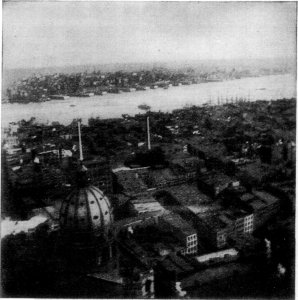
From a photograph taken from a kite by Mr. W.A. Eddy.
A tandem of six or eight six-foot kites exerts a pull of thirty pounds or more on the main line; but it must not be assumed that such a tandem would lift and carry through the air a weight of thirty pounds. The weight of thirty pounds would be carried a short distance; but as the weight moved off, there would be a sudden lessening of the resistance on the line, and so of the wind pressure against the kites, which would soon cause them to sink. A tandem of strong kites in a good breeze might be made to operate a sort of jumping apparatus which, after being carried a short distance, would anchor itself to the ground until the renewed strength of the kites lifted it up again for another jump. [pg 385]But all kite experts are agreed that a kite's power for lifting loads clear of the ground must be enormously increased according as the distance to which the load is to be lifted is increased. It would be possible, for example, to build a tandem of kites strong enough to lift a man clear of the ground, supposing him to be swung in a basket from the main line. This, indeed, has been actually accomplished. September 18, 1895, in England, Captain Baden-Powell was lifted to a height of one hundred feet on a kite-string supported by five large hexagon kites. But Mr. Eddy calculates that to lift a man of the same weight (one hundred and fifty pounds) to a height of fifteen hundred feet, with a wind blowing at the same rate (twenty miles an hour), would require seven kites with upright and cross-sticks not less than sixty-four feet each in length.
The only other instance on record where a man has been lifted by a kite-cord was in the experiment of the great Australian kite expert, Hargrave, who, on November 12, 1894, placed himself in a sling seat attached to a tandem of his wonderful box kites, and was swung sixteen feet clear of the earth. The entire load, including the seat and appurtenances, amounted to two hundred and eight pounds. Mr. Eddy calculates that six of his bird-shaped kites, twenty feet in diameter, would lift a man and basket in safety to a height of one hundred feet, assuming the wind to be blowing steadily at twenty miles an hour.
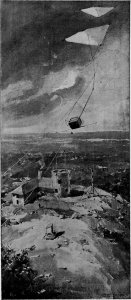
NOTE.—In this picture the square box suspended from the upper line is the camera. The ball hanging from the camera is the burnished signal which, by its fall, informs the operator on the ground when the shutter of the camera has opened. The shutter and the ball are controlled from the ground by the lower line.
Although Mr. Eddy began flying kites as a diversion, he soon saw that there were more serious reasons for continuing his experiments. Having long been interested in meteorological problems, it occurred to him that good results might be obtained by sending aloft, on kite-strings, self-registering thermometers and apparatus for indicating the direction and strength of the air currents. On February 4, 1891, he sent up what is believed to be the first thermometer ever attached to a kite for scientific purposes. This was at nine o'clock in the evening on a cold winter's night, the thermometer registering ten degrees Fahrenheit at the ground. On reading the record after the descent, the thermometer was found to mark six degrees Fahrenheit, which indicated, according to the recognized law of decrease of temperature, that the kite had been sent to a height of one thousand feet. The law is that in ascending from the earth the temperature falls one degree for every two hundred and fifty feet; but subsequent experiments convinced Mr. Eddy that it was by no means to be relied upon as an indication of the height of kites. Not that the law is false; but it holds good only when the meteorological conditions above are the same as at the earth's surface, which is very far from being the case always.
Out of these experiments Mr. Eddy evolved an important theory which has since been abundantly verified. Seeing the frequent variations in the thermometric readings from what the law had led him to expect, he concluded that these were due to meteorological variations overhead; and that changes in the weather, say the approach of warm waves or cold waves, make themselves felt in the air strata above the earth's surface several hours before they can be detected at the surface. Observations extending over months at the Blue Hills Observatory, near Boston, and elsewhere, have abundantly confirmed this theory.
With this fact established, it followed, in Mr. Eddy's opinion, that it was perfectly possible to use kites in making weather prognostications; and, indeed, he has been doing this himself for several years with the best results. Whenever his kite-thermometers, sent to a fixed height which he determines independently by a specially devised kite-quadrant, show actual readings which are either warmer or cooler than the theoretical readings, he prophesies that the weather will, within a few hours, become warmer or colder at the earth's surface, and these prophecies are fulfilled in a large majority of cases. If the kite-thermometers show exactly the temperature which the law would call for, he prophesies that there will be no change in the weather.
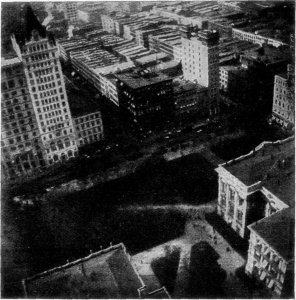
From a photograph taken from a kite by Mr. W.A. Eddy. City Hall Park, New York City, appears in the foreground, with Broadway back of it.
It has also been demonstrated that kites may be used by meteorologists to indicate the approach of storms, which they foretell by a sudden and continuous veering over a considerable arc, usually about sixty degrees. This veering begins usually six or seven hours before a storm, and often as much as twelve hours. And another sure sign of a storm is the continuous and sudden dropping of the kites followed by a quick recovery, which shows that the wind is blowing in gusts interspersed with periods of calm.
[pg 387]In making a series of meteorological experiments which he conducted at the Blue Hills Observatory, Mr. Eddy often employed as many as eight or ten kites; and in August, 1895, he sent up twelve kites on one line, three of them being nine-footers. This is probably the largest number of kites ever sent up in tandem; and although on this occasion the line carried only the thermographs suspended in a basket, the whole weighing not more than two pounds, a very much larger load might have been carried, had it been desired.
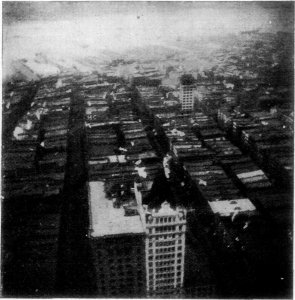
From a photograph taken from a kite by Mr. W.A. Eddy, showing Murray and Warren Streets, New York City, as they run west from Broadway.
Among many other curious things about the wind observed by Mr. Eddy, is the fact that the night winds are by far the steadiest and most satisfactory for kite-flying. On this account much of his work with kites has been done in the darkness, although he uses lanterns on the lines to assist him in locating the kites. It has also been demonstrated that the force of the wind increases steadily as the distance from the earth increases. Archibald proved this conclusively, by suspending a series of wind-measuring instruments at intervals along the main line, their registration showing almost invariably greater wind pressure at the higher altitude. Mr. Eddy has furthermore noted that, while the early morning wind is usually very light at the earth's surface, it is almost invariably good aloft; and he has again and again verified the well-established fact that all clouds herald their approach and are accompanied by increased wind velocity.
The modern system of flying kites tandem was devised by Mr. Eddy in 1890, although it was hit upon two years later independently by Dr. Alexander B. Johnson, the distinguished surgeon of the Roosevelt Hospital in New York. The tandem system makes it possible to send kites to far greater altitudes than had ever been previously attained. And here the best record is undoubtedly held by one of Mr. Eddy's tandems, sent aloft at Bayonne, on November 7, 1893. Mr. Eddy began to send up the kites at 7:30 A.M.; but, being hampered by light breezes from the east, found he was kept busy until half-past three in the afternoon in getting nine kites aloft. He had paid out nearly two miles of cord, when the top kite, a little two-footer, stood straight over the spar buoy in Newark Bay. The lowest kite, a six-footer, was hovering some distance inland from the shore, on a line from the shore to Mr. Eddy's house (where the end of the line was anchored) measuring fifty-five hundred feet by the surveyor's map. Taking two observations from the two ends of this base line, Mr. Eddy's kite-quadrant showed angles of thirty-five and sixty-six degrees; and these data, by simple methods of triangulation, were sufficient to determine the altitude of the kite, which was found to be five thousand five hundred and ninety-five feet—or something over one mile. The kites were seen by hundreds of persons during the fifteen hours that they remained up, the experiment coming to an abrupt end at ten o'clock that night by the blowing away of the two upper kites in the increasing wind. The escaped kites disappeared in Newark Bay, along with three thousand feet of the line.
[pg 388]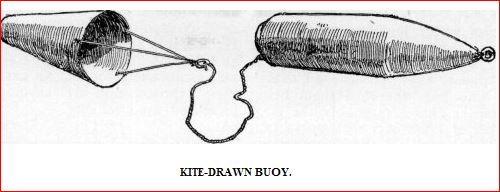
Invented by Prof. J. Woodbridge Davis. This buoy lacks the steering appliances of the one shown below, and travels simply in a line with the kite that draws it.
Much interest attaches from a scientific point of view to experiments designed to test how great an altitude may be reached by kites; and for a year past Mr. Eddy has been working in this direction for the Smithsonian Institution, the hope being that he will ultimately succeed in sending kites two miles above the earth's surface. Professor Langley has been following these experiments with great interest, and has furnished Mr. Eddy with a special quality of silk cord which, it is believed, will give better results in meteorological observation than the ordinary hempen twine or rope. The great difficulty that Mr. Eddy finds in the way of making his kites reach great altitudes, is the pull on the cord, which increases greatly as the kites rise higher. It is probable that a tandem of fifteen or twenty big kites, reaching to a mile above the earth's surface, would exert a pull of one hundred pounds; while at a height of two miles they might, Mr. Eddy thinks, exert a pull of three hundred and fifty pounds; and at a height of three miles, a pull of seven hundred pounds. However great the pull, it is essential to successful flying that the man in control be able to let out or reel in the main line with great rapidity, and it is evident that a dozen men could not by hand alone accomplish this if the kites were sent as high as might be. It is likely, therefore, that, as the importance of scientific kite-flying becomes more widely understood, some simple dummy engine will be devised for rapidly turning the windlass on which the main line is wound.
Mr. Eddy has made frequent experiments with rain-kites, which he used for the first time in November, 1893. It is true that Franklin sent up a flyer during a shower, but in his case the rain was merely an accident accompanying the electric storm, which was his only concern. Mr. Eddy, however, has sent up kites in the rain for the purpose of studying cloud altitudes and other meteorological phenomena; and by this means he has discovered what was not previously believed to be true: that clouds sometimes sink to within six hundred feet of the earth's surface without actually coming down to it. In fact, Mr. Eddy has had kites disappear in a cloud at a height of only five hundred and sixty-eight feet. It has sometimes happened that clouds settling toward the earth have obscured the kites gradually, the top one becoming invisible first, and then the others in succession. Mr. Eddy has found that by such indications he is able to foretell the approach of fog four or five hours before it reaches the earth's surface, so slowly do the clouds settle through the air strata.

This is the buoy invented by Prof. J. Woodbridge Davis for conveying messages, food, or life-lines between disabled vessels and the shore. The buoy is drawn over the water by the kite-line, like the one shown above, but the setting of the keel and the three guy-ropes give it whatever direction is desired.
It is best to make rain-kites of oil-skin or paraffine paper, as the ordinary paper or cloth becomes saturated with the dampness and very heavy, thus lessening the buoyancy of the line. So penetrating is the dampness of clouds, even without a rain-storm, that the wooden frames sometimes become warped and the paste seams soak open.
The scientific kite-flyer will find much to tempt him into the field of electricity; and will be able, not only to duplicate Dr. Franklin's historic experiment of bringing down sparks from the heavens, but may go far beyond this, taking advantage of the greater knowledge of electricity at his disposal and the superior apparatus. In the summer of 1885, Alexander McAdie, at the Blue Hills Observatory, got strong sparks at the earth's surface from a wire connected with a kite whose surface had been coated with tinfoil so as to form an electric collector. He also, by the brightness and increased lengths of the sparks obtained, proved that the electric force in the atmosphere is very greatly increased with the approach of thunder clouds; and also that this force increases steadily as the kites reach greater altitude, and vice versa. Indeed Mr. Eddy and others who have conducted similar experiments, have found the electric force so strong at certain altitudes as to make the manipulation of the conducting wire a source of considerable danger.
On October 8, 1892, Mr. Eddy made an important advance in electrical experiments with kites, by using a collector quite separate from the kites themselves, which were merely used in tandem to support the line on which the collector was swung and raised to any desired altitude. By this arrangement any accident that might befall one of the kites is less likely to ruin the whole experiment.
Much experience with the kite-collector has convinced Mr. Eddy that there is always in the air overhead, at all times of the year and in all weathers, an abundant, practically a boundless, supply of electricity. It has never yet happened to him to send his collector up to even so low a height as four hundred feet without getting a spark in his discharge-box at the earth. He has discovered, however, that the greater the amount of moisture in the air, the greater is the height to which he must send the collector before getting the first spark. There is no doubt that large quantities of electricity might be obtained by hoisting large collectors, supported by strong flying tandems, to considerable altitudes, and drawing off the supply at the earth by means of a system of transformers which would lower the electricity from the dangerously high tension at which it discharges down the wire, to a voltage that could be handled with safety. In his experiments thus far, Mr. Eddy has discharged the copper wire leading from his collector into a wooden box containing a pasteboard wheel with darning-needle axle and tinfoil edges. The axle is grounded, and the copper wire from the collector placed near the tinfoil periphery of the wheel, so as to discharge its sparks through the intervening distance, and by the shock cause the wheel to turn.
One of the most interesting applications of the kite, but a thoroughly practical one, is its use in photography. This has been entirely developed within the past year or two; indeed the first kite-photograph taken on the American continent was one made by Mr. Eddy's camera on May 30, 1895. Although some attempts in this direction had been previously made in Europe, this was the first clearly focused kite-photograph obtained. The previous ones had been blurred, owing to defects in the devices for swinging the camera apparatus from the kite-cord, and for loosening the shutter. Mr. Eddy's apparatus will be better understood from the accompanying cut than from any description. In a general way it is a wooden frame capable of holding the camera, and terminating behind in a long stick or boom, by means of which the camera is made to point in any desired direction or at any angle. This is arranged before sending up the apparatus, the boom being properly placed and held in position by means of guy cords from the main kite-line. A separate line hangs from the spring of the camera shutter, with which is also connected a hollow ball of polished metal supported in such a way that it will drop from its position, five or six feet through the air, when the camera cord is pulled. The purpose of this ball is to allow the operator on the ground to be sure that the camera has responded to his pull and that the desired photograph has been taken. He is assured of this, having given the pull, on seeing the flash made by the polished ball in its fall.
All this being arranged, it is only necessary [pg 391]to send the camera up to any desired altitude and pull the camera cord, in order to get photographs of wide-stretching landscapes, extensive cities, like New York, and panoramas of every description. Such photographs could not but be of the greatest value to geologists, mountain climbers, surveyors, and explorers. And they must possess particular interest for students of geography and for map-makers.
It is obvious, too, that kite-photographs might be of great value in time of war, since a detailed view of an enemy's lines and fortifications might be thus obtained; while at sea a perfected kite-photographing apparatus might be of great value in recording the approach of an enemy's ships. Mr. Eddy regards it as perfectly possible to send up a tandem of kites from the deck of a man-of-war, with a circular camera, such as has already been devised, attached to the main line, and an apparatus for snapping all the shutters simultaneously; and photograph, not only the whole horizon as seen from the deck of a vessel, but, because of the greater elevation, many miles beyond. A battle-ship provided with this photographing device would enjoy as great an advantage as if it were able at will to stretch out its mainmast into a tower of observation a mile high.
It is true that some of the lenses in the circular camera, the ones facing the sun, might give imperfect pictures; but in whatever position the sun might be, at least one hundred and eighty degrees of the horizon would be clearly photographed. And by taking such observations in the early morning, and again in the middle of the afternoon, it would be possible to cover the whole circuit, and thus be aware of the approach of an enemy's ships long before they would have been visible to a telescope used on the deck. In such a circular camera each lens would be numbered, and the position of each would be accurately determined with regard to the points of the compass by the use of guy-cords stretching from the main line to the framework of the apparatus. Thus, on looking at the number of a lens, the photographer would immediately know from which direction any vessel whose image was shown might be coming.
Nor is the use of the kite in war limited to the services it would render in photography; it might easily do more than that, and become a most efficient and novel engine of destruction. As has been shown, it is merely a question of carpenter work to send up a tandem of kites that will swing a heavy load high in the air. Suppose that load were dynamite, with an arrangement for dropping it over any desired spot. Mr. Eddy suggests that this might be effected by means of a slow match made by soaking a cotton string in saltpetre, which would be lighted on despatching the load of dynamite, and would burn at a regular rate, say one foot in five minutes, so that the length of the match could be timed to meet the necessities of the case. On burning to its end, the match would ignite a cord holding the dynamite in a pasteboard receptacle, one side of which would fall down like the front of a wall-pocket as soon as the restraining cord was burned through; and immediately the dynamite in the box would be launched toward its destination. Mr. Eddy has already carried out an experiment similar to this, in setting loose from high elevations tiny paper aŽroplanes. With a little practice he found he could start the slow match with such precision as to cause the aŽroplanes to burst out into flight at any desired altitude. This interesting and beautiful experiment was performed for the first time by Mr. Eddy on February 22, 1893, when he sent off from a height of one thousand feet forty aŽroplanes, their forward edges weighted with pins for greater stability.
Assuming such an arrangement made for discharging a load of dynamite, Mr. Eddy calculates that, with a twenty-mile breeze, six eighteen-foot kites would lift fifty pounds of the explosive a quarter of a mile in the air and suspend it over a fort or beleaguered city half a mile distant. It would thus be perfectly possible, supposing the wind to be in the right direction, to bombard Staten Island with dynamite dropped from kites sent up from the Jersey shore. It is evident that, for purposes of bombardment, a tandem of kites possesses several advantages over the war balloon. Kites are much cheaper. Then it would be far more difficult to disable them than to disable a balloon, since they offer a smaller mark to the enemy's guns; and even if one or two were destroyed, the others would still suffice to carry the dynamite. Finally, the kites may be sent up without risk to the lives of those who directed them, which is not the case with the balloons.
Another interesting and important application of the modern kite has been conceived [pg 392]by Professor J. Woodbridge Davis, principal of the Woodbridge Boys' School, in New York, who is one of the most famous kite-flyers in the world, in addition to being a distinguished scientist and mathematician. It was Professor Davis who invented the dirigible kite several years ago, three strings allowing the operator to steer the kite from right to left at will or to make it sink to earth. Having perfected this curious kite, which is of hexagon shape, is covered with oiled silk, is foldable, portable, and has a tail, Professor Davis turned his attention to his more recent and important discovery of the dirigible buoy, which bids fair to do much to lessen the dangers of shipwreck. For months past Professor Davis, assisted by Mr. Eddy, has been experimenting on the Kill von Kull with this buoy, and has obtained most encouraging results. There are two kinds, both being designed to be attached to kite lines and drawn over the water by the power of the kite. The simpler variety is merely a long wooden tube about three inches in diameter and shaped very much like a gun projectile, with a cone of tin dragging behind to give steadiness. It is for use only when the wind is blowing in exactly the direction in which it is designed to send a message or carry a rope. It will be observed that, in a large number of cases when ships are driven on rocks, the wind is blowing toward the shore, and in such cases a line of kites would readily carry one of these buoys ashore with the important words inside or the still more important rope following after.
Not satisfied, however, with this buoy, Professor Davis sought some means of making kites draw a load across the water in any direction desired, regardless of the way the wind might be blowing; and, after much thought and calculation, he hit upon what is now known as the Davis buoy, an object that has become familiar to dwellers at Bergen Point and Port Richmond, from the frequent experiments on the Kill that have been carried on during the past year. This form of buoy is much larger than the other, being three or four feet in length; and its essential feature is a deep iron keel that projects below out of the block of wood forming the body. It is evident that this keel will tend to keep the buoy headed in any given direction; and stability of position is further assured by the presence of guy-ropes attached to the main line of the kite. Each buoy is provided with three of these ropes, which, by being lengthened or shortened, may cause the buoy to form any desired angle with the kite-cord, and to keep it. Professor Davis has entirely succeeded in making the kites drag the buoy along the water in various directions in the very strongest gales—in fact, under precisely the conditions that would assist when the buoys would be needed for life-saving service from wrecks. And he is positive that, with further experiment, he will be able, by moving along the shore until a tacking angle is reached, not only to send lines, food, or messages to a disabled vessel from the shore, but to bring back by the same kites and the same buoy other lines and messages from the people in distress.
Considering the important offices of which it has already been proved capable, and the possibility which these suggest of many other practical applications, it is clear that the kite is no longer to be regarded as simply a toy. And this, in turn, suggests anew the familiar truth that, after all, nothing in this world is of small consequence.